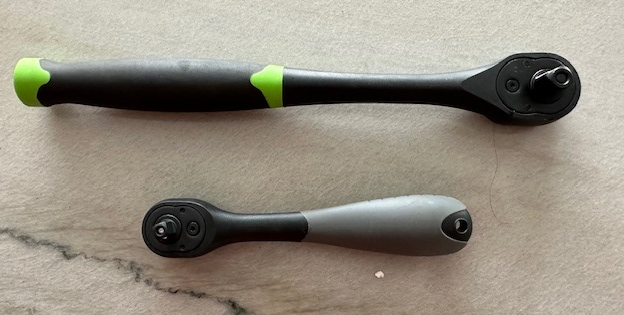A ratchet is a mechanical device commonly used in various DIY projects and professional applications to fasten or loosen bolts and nuts. Commonly used with sockets. It consists of a handle and a rotating head that houses a gear mechanism. This mechanism allows the user to apply torque in one direction while the ratchet handle moves freely in the opposite direction, making it easier to work in tight spaces.
Ratchet History
The ratchet wrench, a crucial tool in modern mechanics, has its origins in the early 20th century. Its invention revolutionized the way mechanical work was performed by allowing continuous motion in one direction while preventing motion in the opposite direction. Over the years, innovations in materials and design have significantly improved the durability and functionality of ratchets, making them indispensable in both DIY and professional toolkits.
Types of Ratchets
- Standard Ratchets
- Flex Head Ratchets
- Swivel Head Ratchets
- Stubby Ratchets
- Electric Ratchets
Ratchet Key Features
- Drive Size: Common sizes include 1/4″, 3/8″, and 1/2″.
- Tooth Count: Higher tooth counts provide finer control.
- Handle Design: Includes ergonomic and non-slip grips.
- Material: Typically made of durable steel or alloy.
- Switch Mechanism: For changing the direction of the ratcheting action.
Choosing the Right Ratchet
Selecting the appropriate ratchet depends on the specific requirements of your project. Consider the size and type of bolts or nuts you’ll be working with, as well as the space available for maneuvering the ratchet. A higher tooth count ratchet is beneficial for working in confined areas, as it requires less movement to engage the next tooth. Additionally, ergonomic handles can reduce hand fatigue during prolonged use.
At a minimum you probably should have at least a 3/8″ drive ratchet and with adapters you can use sockets of other drive sizes. If you perform a lot of DIY projects where sockets of different sizes are needed I would recommend you have ratchets with the 3 common drive sizes.
Ratchet Recommendations
Proper Use and Techniques
Using a ratchet correctly ensures efficiency and prolongs the tool’s life. Begin by selecting the right socket that fits the bolt or nut securely. Attach the socket to the ratchet and set the direction using the switch mechanism. Apply steady pressure while turning the ratchet handle, ensuring that the gear engages correctly. Avoid using excessive force, which can damage the ratchet or the fastener.
Maintenance and Care
Regular maintenance of your ratchet will keep it in optimal working condition. After each use, clean the ratchet to remove dirt and debris. Lubricate the gear mechanism periodically with a light machine oil to ensure smooth operation. Store your ratchet in a dry place to prevent rust and inspect it regularly for any signs of wear or damage.
Safety Tips
- Always wear appropriate personal protective equipment (PPE), such as gloves and safety glasses.
- Ensure that the socket is securely attached to the ratchet before use.
- Use the ratchet only within its specified torque range to avoid breakage.
- Do not use the ratchet handle as a hammer or lever.
- Keep your work area well-lit and free of clutter to prevent accidents.
Conclusion
Ratchets are versatile and essential tools for any DIY enthusiast or professional mechanic. Understanding the different types, features, and proper usage techniques can help you choose the right ratchet for your projects and ensure its longevity. With regular maintenance and adherence to safety tips, a good quality ratchet can serve you well for many years.


